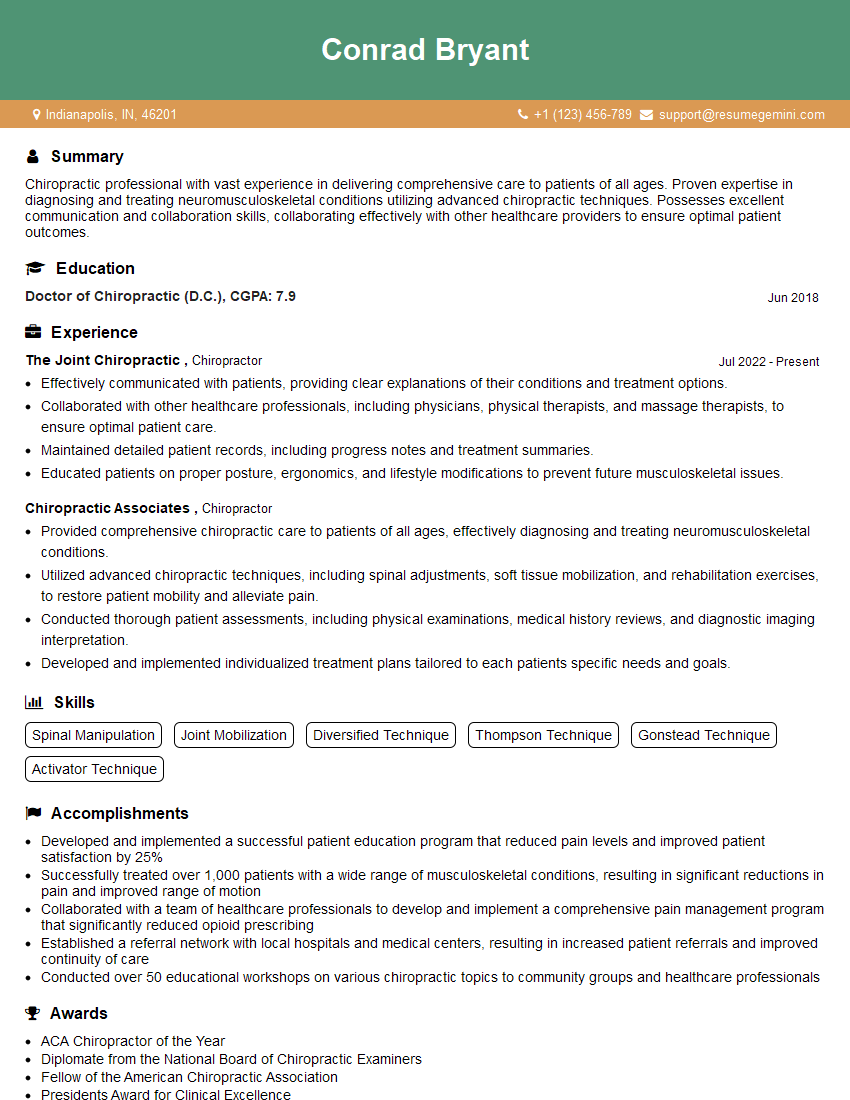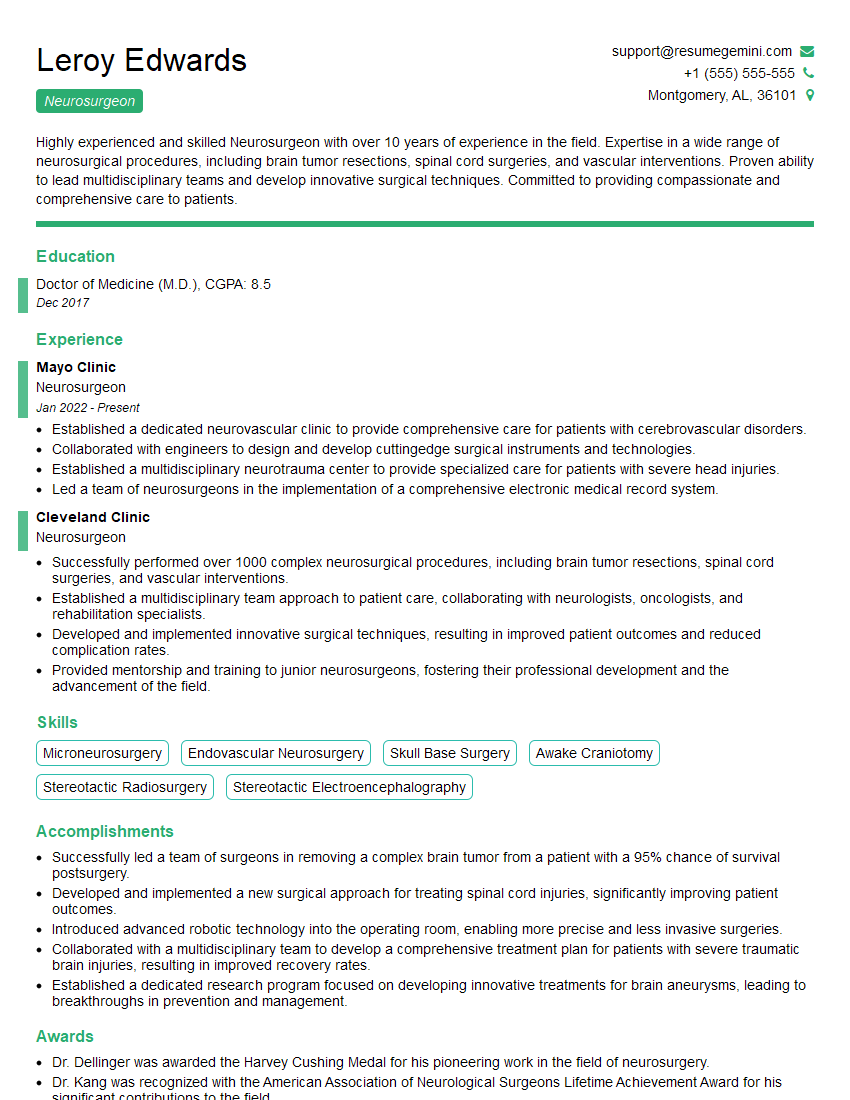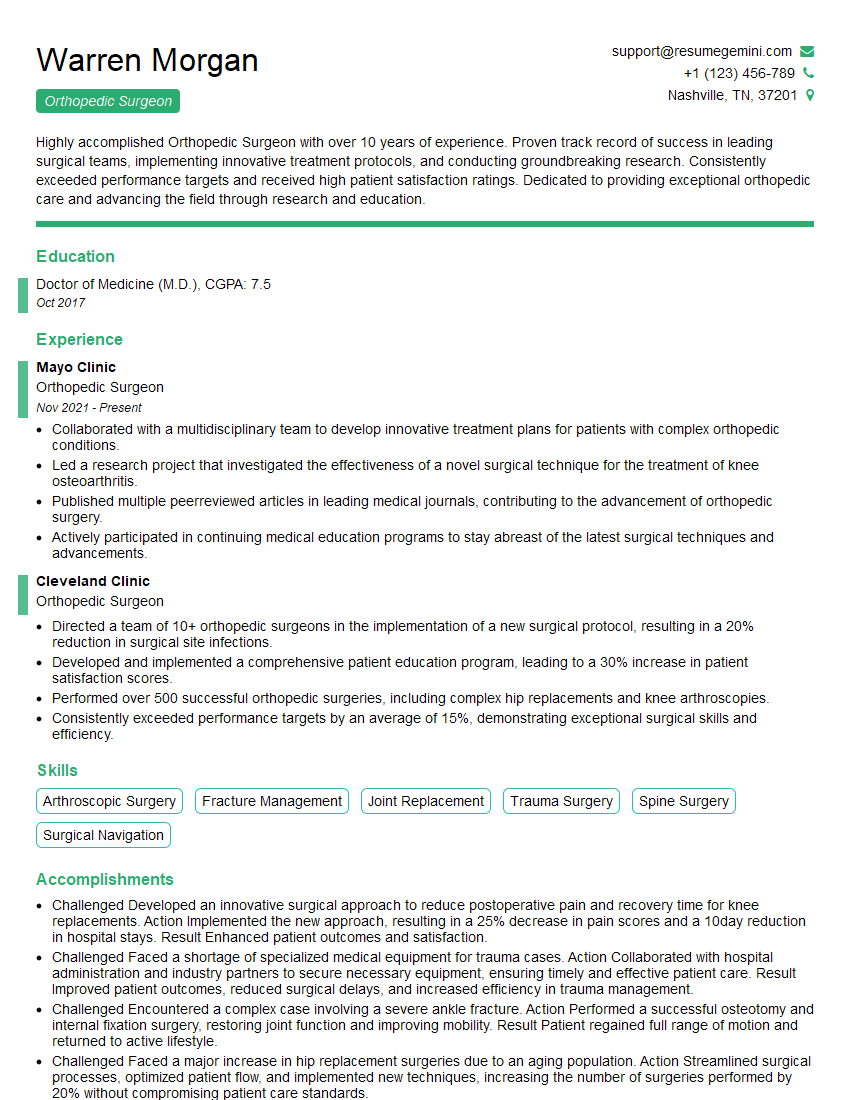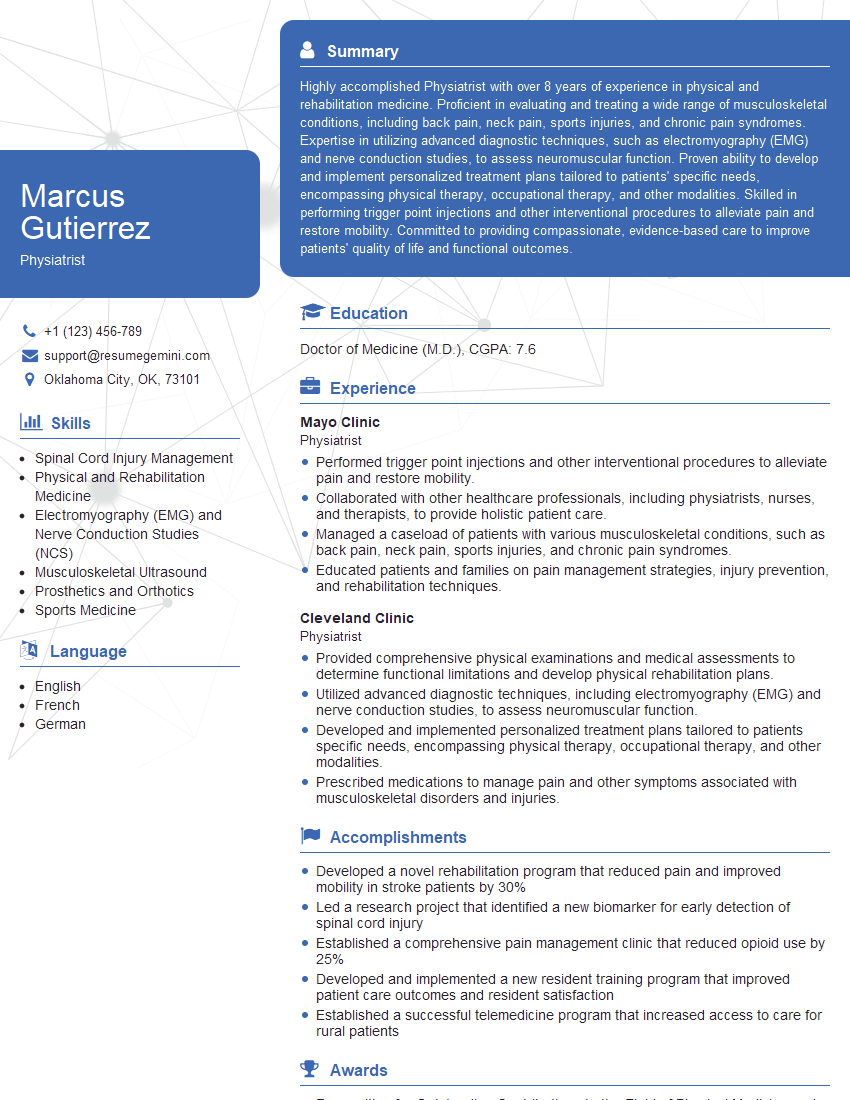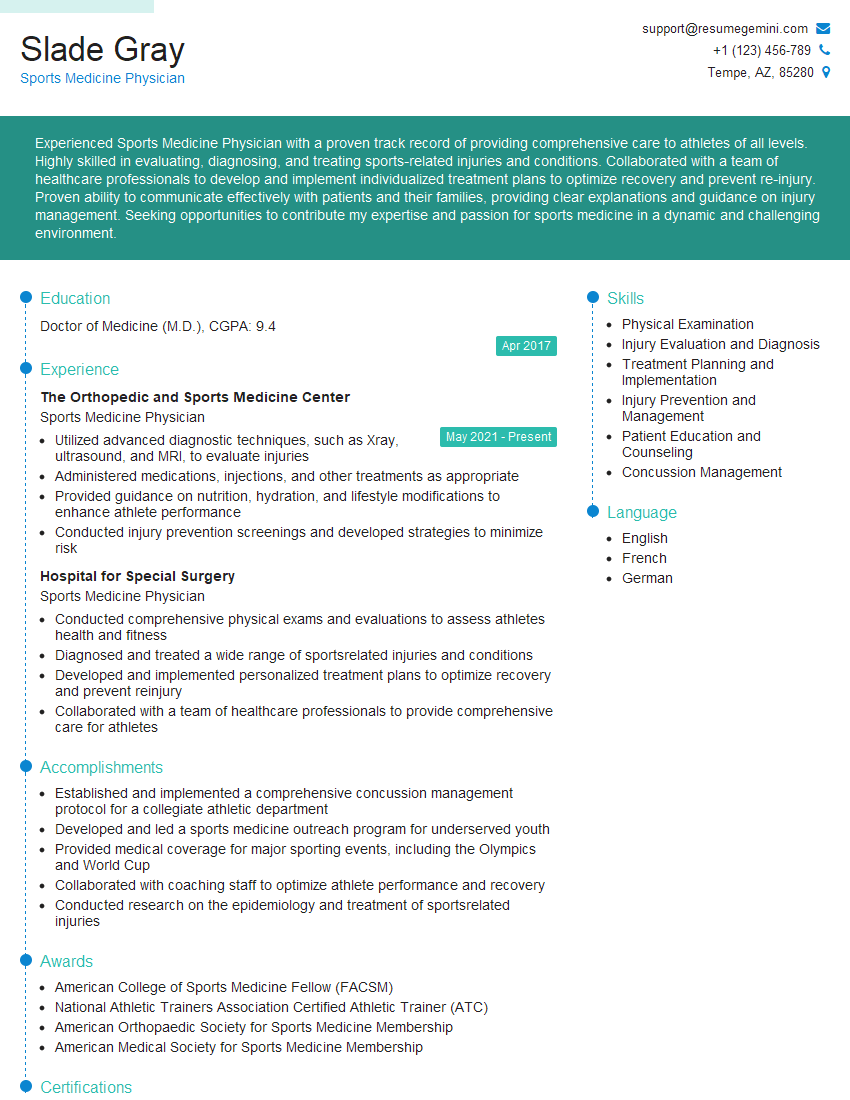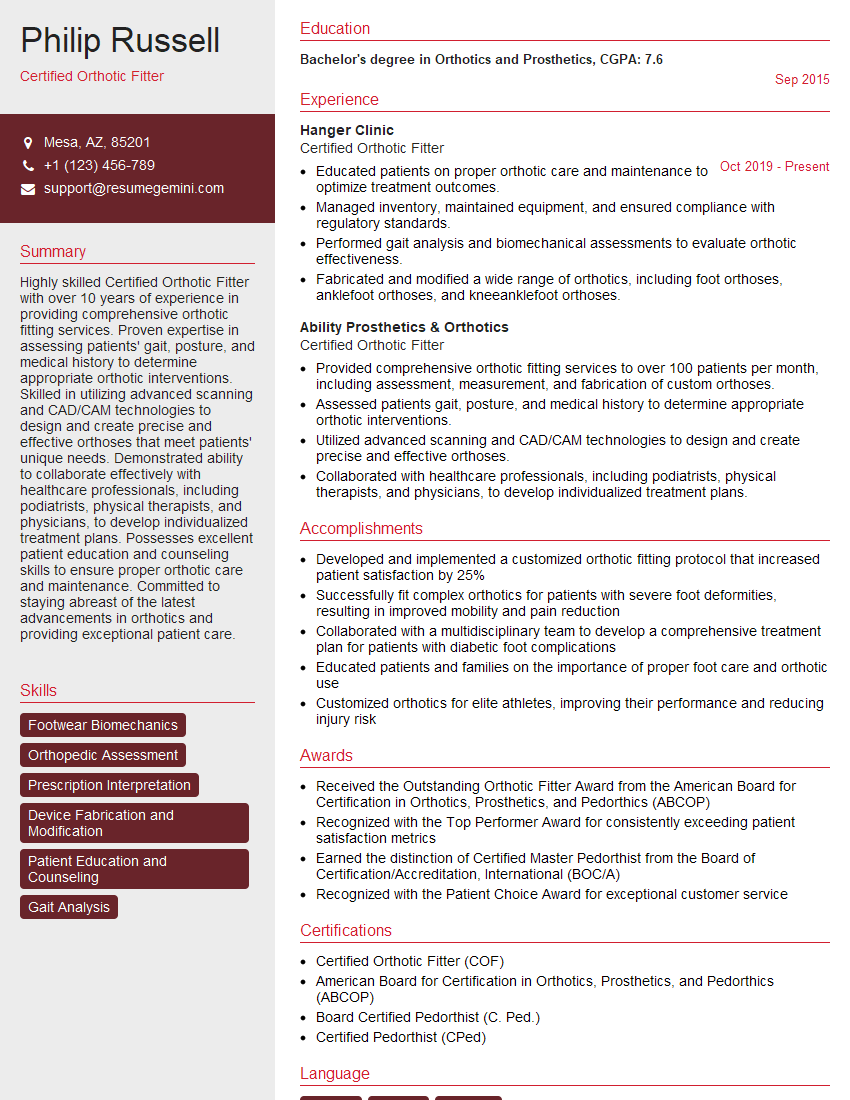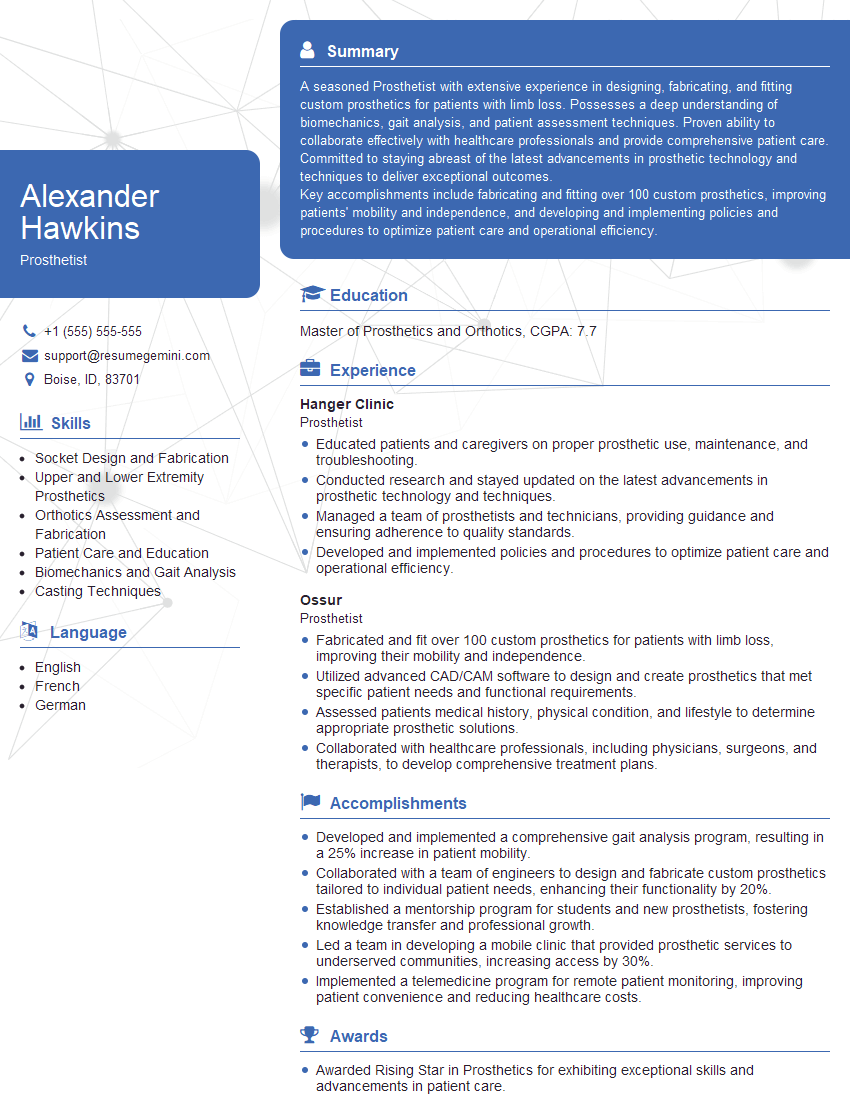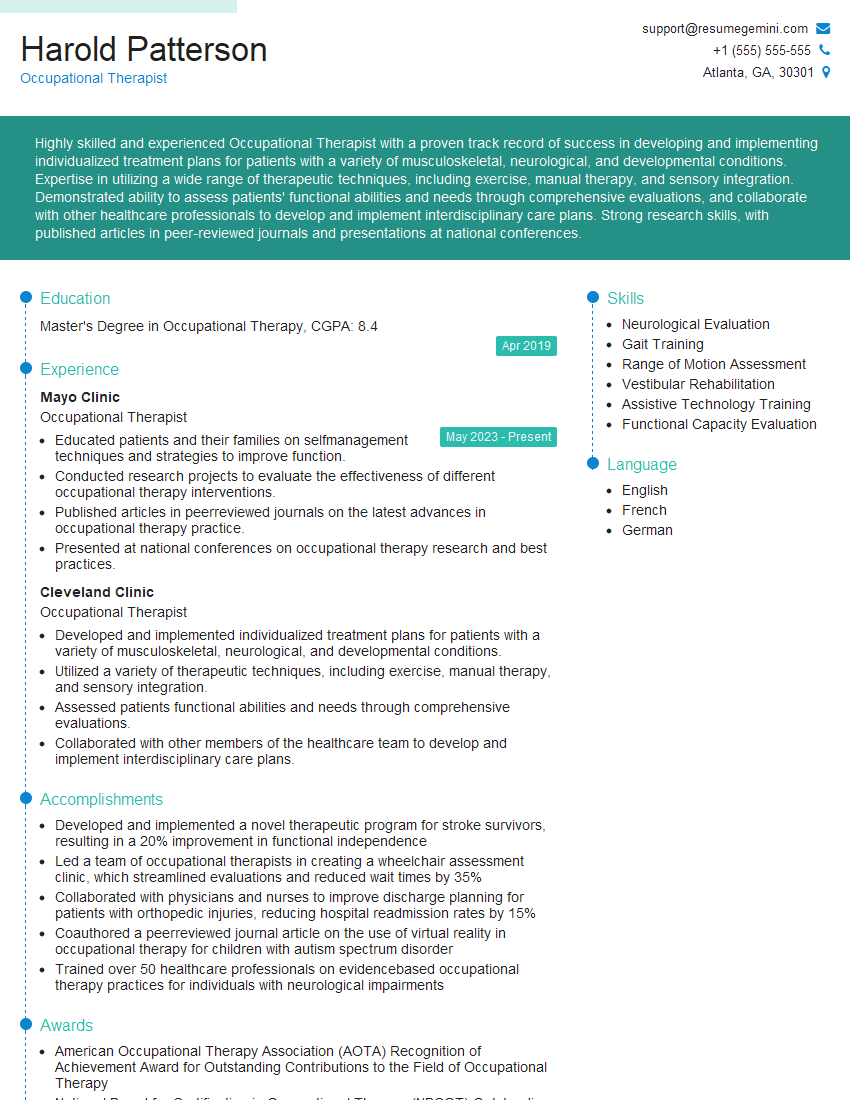Cracking a skill-specific interview, like one for Scoliosis, requires understanding the nuances of the role. In this blog, we present the questions you’re most likely to encounter, along with insights into how to answer them effectively. Let’s ensure you’re ready to make a strong impression.
Questions Asked in Scoliosis Interview
Q 1. Describe the different types of scoliosis.
Scoliosis is broadly classified based on its cause, location, and curve pattern. We primarily categorize it as:
- Idiopathic Scoliosis: This is the most common type, occurring in the absence of any known cause. It’s further subdivided by age of onset: Infantile (0-3 years), Juvenile (3-10 years), and Adolescent (10+ years). Adolescent idiopathic scoliosis is the most prevalent.
- Congenital Scoliosis: This arises from abnormalities in the spine’s formation during fetal development, resulting in malformed vertebrae. These malformations can cause a variety of curvature patterns.
- Neuromuscular Scoliosis: This type is associated with underlying neuromuscular conditions like cerebral palsy, muscular dystrophy, or spinal muscular atrophy. The weakness in the muscles supporting the spine leads to abnormal curvatures.
- Syndromic Scoliosis: This is associated with various genetic syndromes, like Marfan syndrome or Down syndrome, where spinal curvature is a characteristic feature.
Understanding the type of scoliosis is crucial for determining the best course of treatment, as the underlying cause significantly influences management strategies.
Q 2. Explain the Cobb angle measurement and its significance in scoliosis diagnosis.
The Cobb angle is a fundamental measurement used to quantify the severity of scoliosis. It’s determined using an X-ray of the spine. Two lines are drawn, one along the superior endplate of the most tilted vertebra at the top of the curve, and the other along the inferior endplate of the most tilted vertebra at the bottom of the curve. The angle formed by the intersection of these two lines is the Cobb angle.
Its significance lies in guiding treatment decisions. Generally:
- Curves less than 25 degrees: Often monitored with regular check-ups.
- Curves between 25-45 degrees: May warrant bracing to prevent further progression.
- Curves greater than 45 degrees: Usually require surgical intervention to prevent further progression and potential complications.
For example, a Cobb angle of 30 degrees indicates a moderate curve, potentially requiring bracing. A Cobb angle of 60 degrees signals a severe curve that typically necessitates surgery. The Cobb angle, therefore, acts as a critical indicator of scoliosis severity and guides the treatment plan.
Q 3. What are the common clinical presentations of scoliosis?
The clinical presentation of scoliosis can vary significantly depending on the severity of the curve. However, some common signs include:
- Asymmetry of the shoulders or hips: One shoulder blade may be more prominent, one hip higher than the other.
- Uneven waistline: One side of the waist may appear more curved than the other.
- Prominent rib hump: Visible when the patient bends forward (Adam’s forward bend test).
- Back pain: This can be a significant symptom, particularly in adolescents and adults with severe curves.
- Truncal asymmetry: Uneven body posture and alignment.
It’s crucial to remember that not all scoliosis cases present with obvious physical signs, especially in the early stages. Regular screenings, especially during adolescent growth spurts, are vital for early detection.
Q 4. Detail the non-surgical management options for scoliosis.
Non-surgical management of scoliosis primarily focuses on monitoring and conservative interventions aimed at preventing curve progression. Options include:
- Observation: For mild curves, regular clinical examinations and X-rays are essential to monitor curve progression.
- Bracing: Orthopedic braces, such as the Boston brace or Milwaukee brace, are commonly used to prevent further curve progression in moderate curves.
- Physical Therapy: Exercises focused on core strengthening, flexibility, and posture improvement can help manage pain and improve overall spinal health. It’s essential for maintaining overall fitness and managing symptoms.
- Pain Management: Over-the-counter pain relievers, physical therapy, and sometimes targeted injections can help manage associated pain.
The choice of non-surgical management depends on the severity of the curve, the patient’s age and skeletal maturity, and the rate of curve progression.
Q 5. Discuss the indications for surgical intervention in scoliosis.
Surgical intervention for scoliosis is usually considered when conservative measures fail to prevent curve progression, or when the curve is severe enough to cause significant deformity, pain, or respiratory compromise. Indications for surgery generally include:
- Progressive curves greater than 45-50 degrees: This is a common threshold, but the decision can be influenced by other factors, like age and growth potential.
- Significant spinal deformity affecting appearance or function: Severe curves can lead to aesthetic concerns and problems with breathing or heart function.
- Severe pain unresponsive to conservative treatment: If pain significantly impacts quality of life, despite other management efforts, surgery may be considered.
- Risk of curve progression during growth spurts: In adolescents, the potential for significant worsening during growth can prompt surgical intervention.
The decision to operate is made on a case-by-case basis, weighing the potential benefits against the surgical risks.
Q 6. Describe the different surgical techniques used in scoliosis correction.
Several surgical techniques exist for scoliosis correction, each tailored to the individual’s specific needs and curve characteristics. Common methods include:
- Posterior Spinal Fusion: This involves placing bone grafts and metal rods, hooks, and screws along the spine to stabilize and correct the curvature. The fused vertebrae grow together over time, creating a solid, stable spinal segment.
- Anterior Spinal Fusion: This involves an incision at the front of the spine. The surgeon approaches the affected vertebrae from the front to perform a fusion. This approach may be used in certain cases, often in conjunction with posterior fusion.
- Vertebral Column Resection (VCR): This more complex procedure is used for severe curves. It involves removing a section of the severely deformed vertebrae and then reconstructing the spine using bone grafts and instrumentation.
The choice of surgical technique depends on various factors, including the severity and location of the curve, the patient’s age and overall health, and the surgeon’s expertise. The goal is to achieve spinal alignment, stabilize the spine, and reduce pain.
Q 7. Explain the role of bracing in scoliosis treatment.
Bracing plays a crucial role in the non-surgical management of scoliosis, especially in adolescents with moderate curves. Braces, like the Boston brace or Charleston bending brace, work by applying pressure to the convex side of the spinal curve, gently counteracting the curvature. This helps to prevent further progression of the scoliosis, buying time before surgery or allowing the spine to reach skeletal maturity with less curvature.
The effectiveness of bracing depends on several factors, including:
- The severity of the curve: Bracing is generally more effective in moderate curves.
- The patient’s compliance: Consistent wearing of the brace is crucial for effectiveness.
- The patient’s skeletal maturity: Bracing is generally most effective during periods of rapid growth.
While bracing doesn’t cure scoliosis, it’s a valuable tool in slowing or preventing progression, especially in those who are not yet candidates for surgery.
Q 8. What are the potential complications of scoliosis surgery?
Scoliosis surgery, while often highly effective in correcting spinal curvature, carries potential complications. These can range from minor to severe, and the risk varies depending on factors like the patient’s age, overall health, the severity of the scoliosis, and the surgical technique employed.
- Infection: As with any surgery, there’s a risk of infection at the surgical site. This can be managed with antibiotics, but in severe cases, it may require further surgical intervention.
- Nerve damage: The spinal cord and nerves are very close to the surgical area. Damage to these structures can result in weakness, numbness, or paralysis, although this is a relatively rare complication with skilled surgeons.
- Bleeding: Excessive bleeding during or after surgery can necessitate blood transfusions. Careful surgical technique and monitoring minimize this risk.
- Implant failure: The metal rods, screws, and hooks used in scoliosis surgery can sometimes break, loosen, or migrate. This might require revision surgery.
- Hardware removal: In some cases, the hardware may eventually need to be removed, usually years after the initial surgery, depending on factors such as growth and bone maturation.
- Pain: Post-operative pain is expected, but persistent or severe pain is a potential complication that requires attention. Pain management strategies are crucial.
- Pseudoarthrosis (non-union): Failure of the spinal bones to fuse properly is another potential complication, requiring further surgical intervention.
- Dural tear: This rare but serious complication involves damage to the protective membrane surrounding the spinal cord, potentially causing cerebrospinal fluid leaks.
It’s important to remember that these complications are not guaranteed outcomes. A thorough pre-operative assessment, careful surgical planning, and skilled surgical execution significantly reduce the likelihood of these risks. Open communication with the surgical team is key for patients to understand the potential risks and benefits.
Q 9. How do you assess the effectiveness of scoliosis treatment?
Assessing the effectiveness of scoliosis treatment is a multifaceted process involving clinical examination, imaging studies, and patient-reported outcomes. The goal is to determine the extent of curvature correction, improvement in spinal alignment, and reduction of pain and disability.
- Pre and Post-Operative X-rays: These are crucial for measuring the Cobb angle (the angle of the spinal curvature). A significant reduction in the Cobb angle following treatment indicates successful correction.
- Spinal balance assessment: We assess the overall alignment of the spine to ensure proper posture and weight distribution.
- Pain Scales: Visual Analog Scales (VAS) and other pain questionnaires help quantify the patient’s subjective experience of pain before and after treatment. A reduction in pain scores indicates improvement.
- Functional assessments: These assess the patient’s ability to perform daily activities, such as walking, bending, and lifting. Improvement in functional capacity suggests better treatment outcomes.
- Quality of life questionnaires: These assess the patient’s overall well-being and satisfaction with treatment.
- Regular follow-up appointments: Long-term monitoring is essential to detect any potential complications or changes in spinal alignment. This allows for timely intervention if needed.
The assessment process is tailored to the individual patient and their specific condition. For instance, a patient treated conservatively (bracing, physiotherapy) will have a different assessment strategy compared to a patient who has undergone surgery.
Q 10. What are the long-term implications of untreated scoliosis?
Untreated scoliosis can lead to several long-term implications, the severity of which depends on the degree of curvature and the patient’s age. A minor curve might not cause significant problems, while a severe curve can have profound effects.
- Increased curvature: The curve typically progresses, especially during growth spurts in adolescence. This can lead to more pronounced spinal deformity.
- Chronic pain: Back pain, shoulder pain, and hip pain are common in adults with untreated scoliosis. The pain can be debilitating and affect daily activities.
- Respiratory problems: Severe curves can restrict lung capacity, leading to shortness of breath and increased susceptibility to respiratory infections.
- Cardiovascular issues: In severe cases, the curvature can compress the heart and major blood vessels, potentially affecting cardiovascular function.
- Reduced quality of life: The physical limitations imposed by untreated scoliosis can significantly impact daily life, affecting mobility, social activities, and overall well-being.
- Psychological impact: The visible deformity can lead to body image issues and psychological distress.
- Early degeneration of spinal joints: The uneven stresses on the spine can cause premature wear and tear of the intervertebral discs and facet joints, leading to osteoarthritis.
For example, a young adult with a severe, untreated scoliosis might experience chronic back pain, difficulty breathing, and psychological distress, significantly impacting their ability to work and participate in social activities.
Q 11. Discuss the role of imaging (X-ray, MRI) in scoliosis diagnosis and management.
Imaging plays a pivotal role in the diagnosis and management of scoliosis. X-rays and MRIs provide different but complementary information.
- X-rays: These are the primary imaging modality for diagnosing scoliosis. They provide a clear image of the spine’s bony structure, allowing for accurate measurement of the Cobb angle (the angle of curvature) and assessment of spinal alignment. X-rays are also used to monitor the progression of the curve and to evaluate the effectiveness of treatment.
- MRIs: While X-rays focus on bone, MRIs provide detailed images of the soft tissues surrounding the spine, including the spinal cord, nerves, muscles, and ligaments. MRIs are particularly useful in identifying underlying causes of scoliosis, such as neuromuscular disorders or congenital anomalies. They are also helpful in assessing the spinal canal for any compression on the spinal cord or nerves.
In a practical scenario, a patient suspected of having scoliosis would first undergo an X-ray to confirm the diagnosis and measure the curvature. If there is an underlying suspicion of a neurological cause or if the curve is severe, an MRI may be ordered to rule out any neurological compromise or other anomalies.
Q 12. Explain the difference between idiopathic, congenital, and neuromuscular scoliosis.
The three main types of scoliosis – idiopathic, congenital, and neuromuscular – differ in their underlying causes.
- Idiopathic scoliosis: This is the most common type, accounting for about 80% of cases. The cause is unknown, although genetic factors are believed to play a role. It often presents during childhood or adolescence and progresses during growth spurts.
- Congenital scoliosis: This type results from abnormalities in the development of the spine during fetal life. These abnormalities can involve the formation of the vertebrae themselves or the way they fuse together. Congenital scoliosis often requires more aggressive treatment due to the potential for rapid progression.
- Neuromuscular scoliosis: This is caused by underlying neuromuscular disorders that weaken the muscles supporting the spine. Conditions such as cerebral palsy, muscular dystrophy, and spina bifida can cause neuromuscular scoliosis. The curvature is typically progressive and often more severe than idiopathic scoliosis.
Differentiating between these types is crucial for determining the most appropriate treatment strategy. For instance, idiopathic scoliosis may be managed conservatively with bracing in milder cases, while congenital or neuromuscular scoliosis often requires more aggressive intervention, potentially including surgery.
Q 13. Describe the process of pre-operative planning for scoliosis surgery.
Pre-operative planning for scoliosis surgery is a meticulous process involving a multidisciplinary team. It ensures the safest and most effective surgical outcome.
- Detailed history and physical examination: A comprehensive assessment is crucial to understand the patient’s medical history, the severity of the scoliosis, and any associated conditions.
- Imaging studies: X-rays and possibly an MRI are essential to accurately map the spinal curvature, assess spinal balance, and identify any underlying anatomical variations.
- 3D modeling: Sophisticated computer software is used to create a 3D model of the spine, allowing surgeons to plan the precise placement of implants and predict the outcome of the surgery.
- Surgical planning: The surgical team determines the appropriate surgical technique (e.g., posterior spinal fusion, anterior spinal fusion, or a combination), the type and size of implants, and the extent of the fusion.
- Pre-operative optimization: The patient’s overall health is optimized through measures like nutritional support, addressing any respiratory or cardiac concerns, and optimizing their pain management plan.
- Patient education and consent: The surgeon carefully explains the procedure, its risks and benefits, and the post-operative care plan to the patient and their family. Informed consent is obtained before the surgery.
For example, a complex case of congenital scoliosis may involve extensive pre-operative planning, including multiple consultations with specialists, advanced imaging studies, and detailed 3D modeling to ensure a successful surgical outcome while minimizing risks.
Q 14. What are the post-operative care considerations for scoliosis patients?
Post-operative care for scoliosis patients is critical for ensuring successful recovery and minimizing complications. It involves a multidisciplinary approach involving surgeons, nurses, physiotherapists, and other healthcare professionals.
- Pain management: Post-operative pain is managed using a combination of analgesics, including medications and potentially regional nerve blocks.
- Respiratory care: Deep breathing exercises and incentive spirometry are used to prevent post-operative respiratory complications.
- Early mobilization: Patients are encouraged to mobilize as soon as they are medically stable to prevent complications such as deep vein thrombosis (DVT) and pneumonia.
- Physical therapy: A comprehensive physiotherapy program is crucial for improving strength, flexibility, and range of motion. This includes exercises to strengthen core muscles and improve posture.
- Nutritional support: Proper nutrition is essential for optimal healing and bone growth.
- Follow-up appointments: Regular follow-up appointments with the surgical team are necessary to monitor healing, assess any complications, and adjust the treatment plan as needed.
- Bracing (if necessary): In some cases, bracing may be used post-operatively to support the spine while it heals.
A typical post-operative course might involve a few days in hospital, followed by outpatient physiotherapy sessions and regular follow-up appointments over several months or years. Adherence to the physiotherapy program is critical for achieving optimal results.
Q 15. How do you counsel patients and families about scoliosis treatment options?
Counseling patients and their families about scoliosis treatment is a crucial aspect of my practice. It involves a compassionate and thorough explanation of the condition, its progression, and available treatment options. I begin by clearly explaining the diagnosis, using relatable analogies to help them understand the curvature of the spine. For instance, I might compare it to a slightly bent tree trunk. Then, I discuss the severity of the curve using the Cobb angle measurement, explaining what it means in terms of potential impact on their health and appearance.
We then explore treatment options, which are tailored to the individual’s age, curve severity, skeletal maturity, and overall health. This usually includes:
- Observation: For mild curves, regular monitoring with X-rays might be sufficient.
- Bracing: For moderate curves in growing children, bracing helps to slow the progression of the curve.
- Physical Therapy: Strengthening core muscles improves posture and reduces pain.
- Surgery: For severe curves, surgical intervention, such as spinal fusion, may be necessary to correct the deformity and prevent further progression.
Throughout this process, I actively involve the patient and family in decision-making. I answer their questions openly and honestly, addressing their concerns and fears. This collaborative approach ensures that everyone understands the treatment plan and feels comfortable moving forward.
Career Expert Tips:
- Ace those interviews! Prepare effectively by reviewing the Top 50 Most Common Interview Questions on ResumeGemini.
- Navigate your job search with confidence! Explore a wide range of Career Tips on ResumeGemini. Learn about common challenges and recommendations to overcome them.
- Craft the perfect resume! Master the Art of Resume Writing with ResumeGemini’s guide. Showcase your unique qualifications and achievements effectively.
- Don’t miss out on holiday savings! Build your dream resume with ResumeGemini’s ATS optimized templates.
Q 16. How do you manage scoliosis in adolescents versus adults?
Managing scoliosis differs significantly between adolescents and adults. In adolescents, the primary goal is to prevent further curve progression, as their skeletons are still growing. This involves careful monitoring of curve progression using serial X-rays. Bracing is often employed for moderate curves to prevent further worsening. Surgical intervention may be considered for severe curves (typically >45-50 degrees) to prevent significant respiratory or cardiac compromise.
Adult scoliosis management, on the other hand, focuses on pain management and functional improvement. While surgical intervention is still possible for severe adult curves causing significant pain or neurological issues, the decision-making process differs as the primary goal is to alleviate symptoms and improve quality of life rather than preventing progression. Conservative management, including physical therapy, pain medication, and bracing for pain relief, often plays a larger role in the adult population. The surgery becomes more complex in adults due to potential pre-existing conditions and reduced bone density.
Q 17. What are the current trends and advancements in scoliosis treatment?
The field of scoliosis treatment is constantly evolving. Several exciting advancements are shaping current practice:
- Minimally Invasive Techniques: Surgeons are increasingly employing minimally invasive surgical approaches, reducing the size of incisions, blood loss, and recovery time. These techniques reduce the trauma to surrounding muscles and tissues.
- Improved Instrumentation and Implants: Advancements in implant technology, including the use of biocompatible materials and improved designs, lead to better correction and stability of the spine.
- Computer-Assisted Surgery: Computer-assisted navigation systems and 3D-printed implants allow for more precise surgical planning and execution, leading to better outcomes and reduced risks.
- Growth-Guiding Technology: For children, technologies like magnetic growing rods offer a less invasive alternative to traditional spinal fusion, allowing for spinal growth management without the immediate need for fusion.
- Enhanced Post-operative Care and Rehabilitation: Improved post-operative care protocols, including advanced pain management techniques and accelerated rehabilitation programs, help patients return to their normal activities faster.
These advancements offer improved accuracy, less invasiveness, faster recovery times, and better long-term outcomes for scoliosis patients.
Q 18. Describe your experience with specific surgical techniques (e.g., posterior spinal fusion).
Posterior spinal fusion is a common surgical technique I utilize for the correction of severe scoliosis. It involves the placement of bone grafts and metal instrumentation (rods, screws, hooks) to fuse the vertebrae together, correcting the curve and stabilizing the spine. My experience encompasses various aspects of this procedure, from pre-operative planning involving detailed 3D imaging analysis to intra-operative technique and post-operative care.
I’ve performed numerous posterior spinal fusions utilizing different instrumentation systems, adapting my technique to suit the individual patient’s anatomy and curve pattern. This often involves careful consideration of the spinal nerves, minimizing risk to neurological structures. The meticulous preparation, precise surgical execution, and careful follow-up are paramount for achieving optimal outcomes and minimizing complications. I carefully document each surgical case for continued learning and refinement of my techniques.
Q 19. How do you address patient concerns and anxieties about scoliosis and its treatment?
Addressing patient concerns and anxieties is a critical part of my role. Scoliosis, especially in adolescents, can be emotionally challenging. Patients often worry about their appearance, social life, future activities, and potential complications of surgery. I address these concerns through open communication, empathy, and active listening.
I provide a safe and supportive environment for them to express their feelings and fears. I explain the treatment options clearly, answer their questions thoroughly, and involve them in the decision-making process. I also involve family members in these discussions, ensuring they are informed and understand the implications. When necessary, I refer patients to mental health professionals to address any underlying psychological concerns. My goal is to empower patients and their families to make informed choices and navigate their journey with scoliosis with confidence and resilience. I often share success stories of other patients to build their confidence.
Q 20. Describe your experience working with multidisciplinary teams in scoliosis care.
Multidisciplinary care is fundamental to optimal scoliosis management. I regularly collaborate with a team of specialists, including orthopedic surgeons, neurosurgeons, physical therapists, anesthesiologists, pain management specialists, and nurses. This collaborative approach ensures a holistic approach to patient care.
For instance, physical therapists play a critical role in pre- and post-operative rehabilitation, ensuring patients regain strength and mobility. Anesthesiologists ensure safe anesthesia during surgery. Pain management specialists help manage post-operative pain. Regular communication and coordination among the team members ensure that every patient receives tailored, high-quality care, maximizing their outcomes and minimizing potential complications.
Q 21. How do you monitor patients’ progress after scoliosis surgery?
Post-operative monitoring after scoliosis surgery is crucial to ensure proper healing and recovery. This involves regular follow-up appointments involving clinical examinations and radiological imaging (X-rays). We meticulously monitor for potential complications, including infection, instrumentation failure, and neurological issues. We closely monitor patients’ pain levels and functional status. Regular assessment of spinal alignment using X-rays is critical to confirm the correction of the curve and detect any potential changes.
The intensity of the follow-up gradually decreases over time, transitioning from frequent visits in the early post-operative period to less frequent long-term monitoring. The patients are encouraged to participate actively in physical therapy and a gradual return to normal activities, tailored to their individual progress and recovery. This ongoing monitoring helps to identify and manage any potential issues promptly, maximizing long-term outcomes and quality of life.
Q 22. Explain your understanding of the role of physiotherapy in scoliosis management.
Physiotherapy plays a crucial role in scoliosis management, primarily focusing on non-surgical approaches. Its aim is to improve spinal alignment, reduce pain, enhance muscle strength and flexibility, and improve overall posture and function. This is achieved through a tailored program that may include:
- Specific exercises: These target strengthening the weaker muscles and stretching the tight muscles to improve spinal balance. Think of it like carefully sculpting a piece of clay – we’re gently guiding the spine toward a more balanced position.
- Postural correction techniques: Learning to maintain correct posture throughout the day is vital. We teach patients techniques to actively engage their core muscles and improve their awareness of their body position.
- Manual therapy: This involves hands-on techniques like mobilization and soft tissue massage to improve joint mobility and reduce muscle tension. Imagine it as a gentle tune-up for the musculoskeletal system, addressing stiffness and restrictions.
- Bracing (in certain cases): Physiotherapists may work in conjunction with orthotists to ensure proper brace fitting and patient education on its usage. The brace acts as an external support system, complementing the strengthening and stretching program.
- Patient education: This is paramount. Patients need to understand their condition, the exercises, and the importance of adherence to their treatment plan for optimal results.
The effectiveness of physiotherapy depends on the severity of scoliosis, the patient’s age, and their commitment to the program. It’s often used conservatively for mild to moderate cases, and in conjunction with surgical intervention for severe cases to optimize post-operative recovery.
Q 23. What are the key factors to consider when choosing a treatment plan for scoliosis?
Choosing a scoliosis treatment plan is a multifaceted decision, depending on several key factors:
- Curve severity: Measured by the Cobb angle on X-ray, this determines the risk of progression and the need for intervention. Mild curves might only require observation and physiotherapy, while severe curves may necessitate surgery.
- Curve type: Different types of scoliosis (e.g., idiopathic, neuromuscular, congenital) require tailored treatment approaches.
- Patient age: Skeletal maturity plays a crucial role. Treatment for adolescents focuses on preventing curve progression, while adult treatment focuses on pain management and functional improvement.
- Skeletal maturity: For adolescents, we need to assess if their bones have finished growing to determine the effectiveness of bracing and the prognosis.
- Patient’s overall health: Pre-existing medical conditions can influence treatment decisions.
- Patient preferences and goals: Shared decision-making is key. We consider the patient’s values, concerns, and expectations when crafting a plan.
- Risk-benefit assessment: All treatment options, including surgery, carry potential risks and benefits. A thorough assessment helps us weigh these carefully.
The decision-making process often involves a multidisciplinary team, including orthopedists, neurosurgeons, physiotherapists, and radiologists, ensuring a holistic and patient-centered approach.
Q 24. Describe a challenging case of scoliosis you encountered and how you managed it.
I recall a particularly challenging case of a 14-year-old girl with a severe, rapidly progressing right thoracic curve and a significant left lumbar compensatory curve. She presented with significant pain and respiratory compromise. Initial conservative management with bracing proved insufficient to control curve progression.
The ethical dilemma centered on the optimal timing for surgical intervention. While surgery offered the best chance for curve correction and symptom relief, it carried inherent risks, including potential neurological complications. We meticulously weighed these risks against the potential benefits. After extensive discussions with the patient and her family, including detailed explanations of the surgical procedure and potential complications, we opted for posterior spinal fusion.
Post-surgery, a comprehensive rehabilitation program, including physiotherapy, occupational therapy, and pain management, was implemented. The girl made a remarkable recovery, regaining her mobility and significantly improving her quality of life. This case highlighted the importance of meticulous planning, open communication with the patient and family, and a multidisciplinary approach to managing complex scoliosis cases.
Q 25. What are the ethical considerations related to scoliosis treatment?
Ethical considerations in scoliosis treatment are paramount. They include:
- Informed consent: Patients, or their guardians, must fully understand the diagnosis, treatment options (including risks and benefits), and alternatives before making decisions.
- Shared decision-making: Treatment plans should be developed collaboratively, respecting patient preferences and autonomy. We should always strive for shared decision-making.
- Beneficence and non-maleficence: Our primary goal is to benefit the patient while minimizing harm. This requires careful consideration of the potential risks and benefits of any treatment.
- Justice and equity: Access to high-quality scoliosis care should be equitable, regardless of socioeconomic status or geographic location.
- Confidentiality: Maintaining patient privacy is crucial, respecting sensitive medical information.
Addressing these ethical considerations requires a thoughtful and empathetic approach, ensuring that patient well-being is always prioritized.
Q 26. How do you stay updated on the latest research and advancements in scoliosis?
Staying updated in the rapidly evolving field of scoliosis requires a multi-pronged approach:
- Regularly attending conferences and workshops: Major orthopedic and spinal surgery conferences offer invaluable opportunities to learn about the latest research and treatment techniques.
- Reading peer-reviewed journals: Publications like the Spine journal, Journal of Bone and Joint Surgery, and others provide access to cutting-edge research findings.
- Participating in continuing medical education (CME) programs: These courses provide updated knowledge on specific aspects of scoliosis management.
- Networking with colleagues: Discussions and collaborations with other specialists in the field can broaden understanding and enhance clinical practice.
- Engaging with online resources: Reputable online platforms and professional organizations provide updates on scoliosis research and guidelines.
Continuous learning is not just important but essential for providing optimal care to my patients.
Q 27. What are your strengths and weaknesses in managing scoliosis patients?
Strengths: I possess a deep understanding of scoliosis pathophysiology, diagnosis, and treatment. My experience in managing a wide range of cases, from mild to complex, has honed my clinical judgment and problem-solving skills. I am adept at communicating complex medical information to patients and families in a clear and compassionate manner, fostering collaborative relationships. I am also a strong advocate for shared decision-making and patient-centered care.
Weaknesses: Like any specialist, there are areas where I can always improve. I am always striving to enhance my knowledge of the latest advancements in minimally invasive surgical techniques and innovative bracing technologies. I’m actively working on this through continued education and collaboration with other experts in the field. Further, I am continuously refining my communication skills to better address the emotional and psychological needs of patients dealing with scoliosis.
Q 28. Why are you interested in this position related to scoliosis?
I am deeply interested in this position because it offers a unique opportunity to contribute to a center of excellence in scoliosis care. I am passionate about providing high-quality, compassionate care to patients with scoliosis and believe that my expertise and commitment align perfectly with your institution’s mission. The opportunity to work alongside a team of experienced professionals, share knowledge, and continue learning in a stimulating environment is extremely appealing. I am particularly drawn to [mention a specific aspect of the position or institution that interests you, e.g., the institution’s research focus, its commitment to patient education, its use of innovative technologies].
Key Topics to Learn for Scoliosis Interview
- Scoliosis Classification: Understand the different types of scoliosis (idiopathic, congenital, neuromuscular), their classifications (by curve type, location, and severity), and the implications for treatment.
- Scoliosis Diagnosis: Familiarize yourself with diagnostic methods including physical examination, X-ray analysis (Cobb angle measurement), and other imaging techniques. Be prepared to discuss the interpretation of diagnostic findings.
- Treatment Options: Master the various treatment approaches, from observation and bracing to surgical interventions (spinal fusion, instrumentation). Understand the indications, contraindications, and potential complications of each.
- Bracing Techniques: Explore different types of braces used in scoliosis treatment, their application, and the principles behind their effectiveness. Discuss patient compliance and the role of bracing in curve progression.
- Surgical Planning and Techniques: For advanced roles, be prepared to discuss pre-operative planning, intra-operative techniques, and post-operative management of spinal fusion surgery. Understand the role of instrumentation and fusion in correcting spinal deformities.
- Biomechanics of Scoliosis: Grasp the biomechanical principles underlying scoliosis development and progression. This includes understanding spinal loads, muscle imbalances, and the effects on posture and gait.
- Long-Term Management and Complications: Discuss long-term follow-up care, potential complications (e.g., nerve damage, implant failure), and the importance of patient education and rehabilitation.
- Ethical Considerations: Be prepared to discuss ethical dilemmas related to treatment decisions, informed consent, and patient autonomy in the context of scoliosis management.
Next Steps
Mastering the complexities of scoliosis treatment positions you for significant career advancement in orthopedics, physiotherapy, or related fields. A strong, ATS-friendly resume is crucial for showcasing your expertise and securing your dream role. To create a compelling resume that highlights your unique skills and experience, leverage the power of ResumeGemini. ResumeGemini provides a user-friendly platform and helpful resources to build a professional resume, including examples tailored to the specific demands of a Scoliosis-focused career. Take the next step towards your career goals – build your best resume with ResumeGemini today.
Explore more articles
Users Rating of Our Blogs
Share Your Experience
We value your feedback! Please rate our content and share your thoughts (optional).
What Readers Say About Our Blog
To the interviewgemini.com Webmaster.
Very helpful and content specific questions to help prepare me for my interview!
Thank you
To the interviewgemini.com Webmaster.
This was kind of a unique content I found around the specialized skills. Very helpful questions and good detailed answers.
Very Helpful blog, thank you Interviewgemini team.
